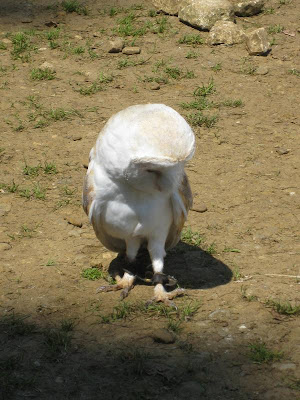 |
| Cotswold Falconry Centre, July 2012 |
Generalities are fine. So I can say that two weeks ago was extraordinary - I had almost no referrals all week, to the extent that I could spend half a day in the library reading about diabetes, and catching up with paperwork, and throwing a lot of accumulated stuff out. Then last week, the tables were turned. One of my colleagues was off sick, and we were just keeping our heads above water even when we discovered at very short notice that she was supposed to be giving a talk on Wednesday, and even though I had a full clinic (11 patients) booked in on Thursday morning (4 DNAs in the end). But on Thursday, the wards decided to go into overdrive, and we received 15 referrals (I think it was 15 - my other colleague had to deal with the inundation during the morning - I was in clinic).
For some reason, Thursday was also the day that I found myself involved in three separate complaints about catering. Afterwards, we decided that in an ideal world I should have just said "This has nothing to do with me; you need to talk directly to catering yourselves." But, as a health professional trained to help people, my instinct is to try and help, even though one complaint was simply that the ward catering staff wouldn't give larger portions to a patient who clearly needed and wanted more to eat. It was very frustrating for all involved.
In the end, you can only do as much as a person can do, and our colleague returned on Friday, and we just about got through everything as best we could. But the team of six is down one anyway since our team leader left, and the most senior of the remaining five of us is covering not just that post but also providing paediatric cover, as we only have one paediatric dietitian for the whole hospital. And one of the remaining five isn't supposed to do anything except stroke, and she had a student with her all week as well. The end of the working week on Friday was a huge relief.
Mr A and I had a treat on Friday night - a return visit to Queans, the restaurant where we first went to celebrate our birthdays earlier in the year. This time we had a voucher which Mr A had earned by doing some work for a neighbour. It was a lot of money, too, enough for dry martinis and three courses for each of us and a bottle of wine. It is a lovely place to spend the evening.
Then on Saturday I volunteered to help out with end-of-season cleaning and clearing up at the Falconry Centre. As a Friend of the Centre, as well as not having to pay to get in, I am invited to a summer barbeque and two cleaning events, one at the end of the season in November when the Centre closes, and the other in February just before the Centre opens again. I'm not entirely sure why I volunteered for this, and most Friends do the sensible thing and just come to the barbeque, but there I was on Saturday, spending a few hours sweeping up leaves in the pouring rain, and getting almost as wet while cleaning the insides of the cages where some of the birds are kept overnight and through the winter.
The birds don't fly at all out of season, mostly because there aren't enough visitors to justify opening the Centre. They don't need to fly - given sufficient food, they are happy to just sit there for a month or two, growing new feathers and thinking whatever birds think when they have nothing to do. There were about six of us volunteers in all, a friendly group, and I'm kind of glad I did it, even though I really didn't have to. I might even volunteer for the February opening workout as well.
No fresh news about the new job. I know I'll almost definitely be leaving if all the bureaucracy gets completed to everyone's satisfaction, and it is likely to be at the end of December all being well, but there are no guarantees. Then another similar vacancy was advertised, much nearer to home, permanent, but only 4 days a week. I mentioned it at work, and was surprised when the consensus was that I should apply, despite being halfway through the process of moving to a different job. So that's my Sunday fully occupied, along with my usual treat of a trip to the greengrocer.




